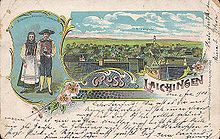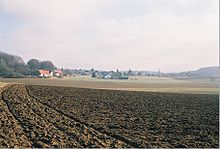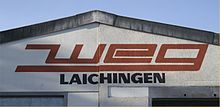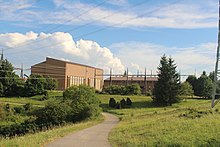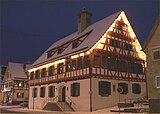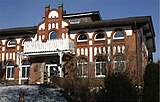Laichingen
| coat of arms | Germany map | |
|---|---|---|

|
Coordinates: 48 ° 29 ' N , 9 ° 41' E |
|
| Basic data | ||
| State : | Baden-Württemberg | |
| Administrative region : | Tübingen | |
| County : | Alb-Danube district | |
| Local government association: | Laichinger Alb | |
| Height : | 755 m above sea level NHN | |
| Area : | 69.84 km 2 | |
| Residents: | 11,731 (Dec 31, 2018) | |
| Population density : | 168 inhabitants per km 2 | |
| Postal code : | 89150 | |
| Area code : | 07333 | |
| License plate : | UL | |
| Community key : | 08 4 25 071 | |
| City structure: | 4 districts | |
City administration address : |
Bahnhofstrasse 26 89150 Laichingen |
|
| Website : | ||
| Mayor : | Klaus Kaufmann (independent) | |
| Location of the city of Laichingen in the Alb-Donau district | ||
Laichingen is a small town in the Alb-Donau district in Baden-Württemberg .
Despite its small size, Laichingen is the largest city in the area. Therefore, together with Blaubeuren, it performs the function of a medium- sized center . It is considered the linen weaving town on the Swabian Alb .
geography
Laichingen is located on the Laichinger Alb, a part of the Swabian Alb . It is located on a former volcanic vent on the Alb plateau, about 25 kilometers west of Ulm .
Neighboring communities
The community borders in the north on Hohenstadt in the district of Göppingen , in the east on Merklingen and Dornstadt , in the south on Berghülen , the city of Blaubeuren and Heroldstatt and in the west on the manor district Münsingen and Römerstein , both in the district of Reutlingen and Westerheim .
history
middle Ages
The name Laichingen is said to go back to the Alemanni chief Laicho, who founded a settlement here in the 5th century AD. In the High Middle Ages, Laichingen was part of the Duchy of Swabia . In 1364, Emperor Charles IV offered the residents city rights . However, these refused because they supposedly did not want to build a city wall.
Old Württemberg time
Laichingen already belonged to the Blaubeuren monastery in the late Middle Ages and thus to the Duchy of Württemberg since the Reformation in 1534 . It was a sub-office in the Urach office.
An elementary school existed at least since 1557.
The tradition of linen weaving in Laichingen goes back to the Middle Ages . The barren soils on the Alb were no longer available, and so the residents switched to growing flax and earning a living through trade with the imperial city of Ulm, about 25 kilometers away .
There used to be a so-called Hüle in the city center of Laichingen . Sleeves were made of weathered volcanic tufa. Water collected in them and they formed the basis for many settlements on the Swabian Alb. The cave served as a cattle trough and for fire extinguishing purposes. The drinking water was laboriously brought in from the valleys.
In the Thirty Years' War, after the battle of Nördlingen lost for Württemberg in 1634, Laichingen was largely destroyed by the victorious emperor's troops marauding in many parts of the country.
Part of the Kingdom of Württemberg
During the implementation of the new administrative structure in the Kingdom of Württemberg , Laichingen came to the Münsingen Oberamt in 1808 . A major fire in 1852 again caused major damage to the structure of the town. From 1871 the Alb water supply was planned and built, to which Laichingen was also connected.
20th century
During the district reform during the Nazi era in Württemberg , Laichingen came to the Münsingen district in 1938 . In 1945 the place became part of the French occupation zone and in 1947 it was assigned to the newly founded state of Württemberg-Hohenzollern , which was added to the state of Baden-Württemberg in 1952.
In 1950, Laichingen was granted town charter again and recorded significant growth. In the 1950s the cave was filled in and gave way to today's marketplace.
Due to the district reform in Baden-Württemberg , Laichingen became part of the Alb-Donau district in 1973.
In the 1970s, some surrounding places were incorporated. Today they form the districts of Laichingen ( see also: Municipal reform in Laichingen ).
In 1987 the so-called Laichinger Hunger Chronicle was exposed as an anti-Jewish forgery.
Many weaving companies are still located in Laichingen today, but they are now producing industrially. One of the weavers' houses built around 1677 stood in Laichingen until 2002. It was dismantled and can now be viewed in the Beuren open-air museum.
Population development
These are population numbers according to the respective territorial status. The numbers are census results (¹) or official updates from the Baden-Württemberg State Statistical Office (only main residences ).
|
|
Denominations
A church and parish of St. Alban was mentioned as early as 1100. The church set came through the Count Palatine of Tübingen to the Blaubeuren monastery , to which it was incorporated with the entire surrounding area in 1421. The Reformation was introduced in 1534. Since then, Laichingen has been predominantly Protestant . The Protestant parish of Laichingen includes the core city. The Feldstetten district forms its own parish, which will be looked after by one of the two Laichingen parish officers from autumn 2020 as part of parish savings. Both parishes belong to the Bad Urach-Münsingen church district of the Evangelical Church in Württemberg . The districts of Machtolsheim and Suppingen also form their own parishes, but within the church district of Blaubeuren . Since 2009, Suppingen and Machtolsheim have become a common parish. In addition to these Protestant parishes, there is a Catholic , Methodist and New Apostolic Church and a Kingdom Hall of Jehovah's Witnesses in Laichingen .
Municipal reform
In the course of the municipal reform in Baden-Württemberg , Suppingen was assigned to the city of Laichingen on January 1, 1972, and Feldstetten and Machtolsheim on January 1, 1975 .
Laichingen forms the largest part of the city.
Coat of arms of the municipalities
politics
Laichingen is the largest municipality in the Laichinger Alb local authority association with Merklingen , Nellingen and Westerheim and Heroldstatt , which is also where it is based.
mayor
- 1980–1996: Andreas Raab , independent until 1984, then CDU ,
- 1996–2012: Friedhelm Werner, FWV
- since December 2012: Klaus Kaufmann, independent
The mayor is elected for an eight-year term. Friedhelm Werner's first term of office ended on December 18, 2004. On October 10, 2004, he was re-elected for a second term with 68% of the vote.
Municipal council
In Laichingen, the municipal council is elected using the spurious selection of a part of town. The number of local councils can change due to overhang mandates . The local elections on May 26, 2019 led to the following preliminary final result. The municipal council consists of the elected voluntary councilors and the mayor as chairman. The mayor is entitled to vote in the municipal council.
| Parties and constituencies | % 2019 |
Seats 2019 |
% 2014 |
Seats 2014 |
||
|---|---|---|---|---|---|---|
| BWV | Civic voters' association | 34.2 | 8th | 36.8 | 10 | |
| LAB | Laichinger general list of citizens | 27.2 | 7th | 25.0 | 7th | |
| HEDGEHOG | Initiative Together Committed to Laichingen | 24.3 | 6th | 18.5 | 5 | |
| CDU | Christian Democratic Union of Germany | 12.9 | 3 | 19.8 | 5 | |
| BbW | Alliance for affordable housing | 1.3 | 0 | - | - | |
| total | 100 | 24 | 100 | 27 | ||
| voter turnout | 56.1% | 50.4% | ||||
coat of arms
The Laichingen coat of arms dates back to 1570 and shows a blue shield with a yellow meadow harrow.
Town twinning
- Since 1986 there has been a town partnership with the French Canton de Ducey .
- Since 1990 friendly relations have been cultivated with the “pottery town” Kohren-Sahlis in Saxony.
- Since 1993 there have been friendly relations with and humanitarian aid for Nesvish in Belarus.
Economy and Infrastructure
Traditionally, weavers are based in Laichingen. Iron processing, especially tool making, also flourished in Laichingen in the 20th century.
Aliud Pharma GmbH, which belongs to the Stada Group , is based in Laichingen.
Laichingen is home to the inter-communal industrial and commercial area Laichinger Alb (IIG) of the association with Heroldstatt , Merklingen , Nellingen and Westerheim .
Laichinger textile industry
The linen weaving was a major industry. In the period after the Second World War , the consequences of the war were still very much felt in the small town of Laichingen, on the border of the American zone of occupation . Many of the Laichingen companies were used during the war to manufacture war-necessary materials, such as parachutes, or even completely cleared out to be used for the metal industry. But after the end of the war, six Laichingen companies received approval from the American military government to be allowed to resume production.
So many looms were rebuilt and started up. When Laichingen passed into the French occupation zone , the textile companies had to hand over many of their goods to the French occupation government as reparation payments . With the currency reform, the shop windows filled up and Laichingen's textile industry was also able to benefit from it. The demand for textiles increased enormously after the war and bed linen from the Laichingen linen weaver was in particular demand. This led to a real boom in this branch of industry. In 1948 all companies in Laichingen were fully employed and a wave of company start-ups followed from 1950 to 1960, as everyone wanted to participate in the upswing. In the next 10 years, many textile goods were manufactured in Laichingen. Large and well-known companies emerged, such as Pichler Textiles and Laundry Crown Laichingen.
traffic
The public transport is the Danube-Iller-Nahverkehrsverbund guaranteed. From 1901 to 1985 Laichingen was connected to the rail network via the Amstetten – Laichingen railway of the Württembergische Eisenbahngesellschaft (WEG) . The Merklingen station is being built as part of the new Wendlingen – Ulm line that is currently under construction, and Laichingen will contribute financially to its costs.
Laichingen has its own airfield , which has been operated by the Flugsportverein Laichingen e. V. is operated.
The Alb-Neckar cycle path reaches Laichingen as a long-distance cycle path . It leads from Ulm to Heilbronn .
From north to south, the Swabian-Alb-Oberschwaben-Weg runs through the center of Laichingen as main hiking trail 7 . This long-distance hiking trail leads from the Remstal to Lake Constance and is looked after by the Swabian Alb Association.
tourism
The Heidehof campsite is located in the suburb of Machtolsheim. With 1050 parking spaces on an area of 25 hectares, it is one of the largest in Germany.
media
The Schwäbische Zeitung has a local editorial office in Laichingen .
education
There are elementary schools in Laichingen, Feldstetten and Machtolsheim. The main town of Laichingen is also a school center with the following schools:
- Erich Kästner Community School, primary level and secondary level 1
- Anne Frank Realschule
- Albert Schweitzer High School
- Martinschule ( special school )
- Branch office of the commercial school Ehingen
- Branch of the industrial school Ehingen
The Adult Education Center Laichingen-Blaubeuren-Schelklingen e. V. is based in Laichingen.
energy
Laichingen is the location of a 380 kV / 110 kV substation , which is designed in compact SF 6 technology and is operated by TransnetBW .
Culture and sights
Churches
- Feldstetten : The Protestant St. Gallus Church was built in 1737, while the Gothic choir of the previous building was also used. Wall paintings from the 14th and 15th centuries can be seen in it. They were only discovered in 1895 and restored in 1898. The artist Walter Kohler designed a choir window with biblical themes in 1936 (healing of the blind, rich youth, raising of Lazarus). In 1999 a color window by the artist Ursula Nollau from (then) Zwiefalten followed.
- Laichingen : The St. Albans Church was mentioned as early as around the year 800 as a forerunner and own church of the Laichingen local nobility, built in the 14th century in its current size and expanded in 1550 with further components to a church castle. In 1632 it received a tower top from the master builder Heinrich Schickhardt , but this has not been preserved. The current tower was built in 1696. In 2008, the church lost the traditional suffix Saint by a resolution of the parish council .
- Machtolsheim : The Evangelical Church of Our Lady was built in 1488 and redesigned in Baroque style in the 18th century: The Deggingen plasterer Johann Ulrich Schweizer created the baroque stucco ceiling in 1712, which was painted in 1745. A comprehensive renovation was carried out around 1934 by the Stuttgart architects Klatte & Weigle .
- Suppingen : The Protestant Brigittenkirche was built in a late Gothic style in 1471 and the nave was designed in a mannerist manner in 1569 . In 1862 a neo-Gothic renovation took place.
The Laichinger Tiefenhöhle
Laichingen is also known for the Laichinger Tiefenhöhle , the only shaft cave in Germany that has been converted into a show cave and is 55 m deep. The cave is about 1 km south of Laichingen. It was discovered by chance in 1892 by the sand digger Johann Georg Mack.
Museums
- Local history and weaving museum Laichingen (in a building of the fortified church)
- Speleological Museum (near the Tiefenhöhle)
Other structures
- Machtolsheim water tower
- In the historic old town hall in the city center, weddings, cultural events and meetings of the municipal council take place.
- The Protestant rectory of the Albanskirche is from the pre-Reformation period and is popularly known as the "Capuchin House".
- The former mill on the Bleichberg was in operation from 1902 to 1972. Originally, the system, which was built at an exposed location 774 meters above sea level, was supposed to run as a windmill and generate additional electricity. North German engineers had constructed a wind turbine with 82 blades and a diameter of 12 meters. The wind turbine was built in Holstein and was in operation for some time in Laichingen behind the striking brick building. However, it did not always produce the required 12 hp, so a gas engine was soon used to assist. A strong storm damaged the wind turbine and it was dismantled.
Personalities
Honorary citizen
- Jean-Pierre Tizon (1920–2012), French politician
sons and daughters of the town
- Karl Nüßle (1816–1892), born in Suppingen, member of the Württemberg state parliament
- Julius Ludwig August Koch (1841–1908), psychiatrist
- Heinrich Lang (1858–1919), university professor, German organist, choir director and composer
- Eugen Eisele (1871–1940), member of the state parliament from 1906 to 1918
- Christof Baumann (1874–1959), born in Feldstetten, Oberamtmann in Württemberg
- August Enderle (1887–1959), politician, trade unionist and journalist
- Karl Baur (1911–1963), pilot
- Helmut Kreuzer (1927–2004), German and media scientist
- Peter Schwenkmezger (1946–2018), psychologist, President of the University of Trier
- Werner Strohm (1934–2001), building contractor, created a large number of buildings and shaped the cityscape
- Gert Hinnerk Behlmer (* 1943), lawyer
- Jan Plamper (* 1970), German Eastern European historian at the University of London
- Alina Reh (* 1997), middle and long distance runner, multiple European champion in the junior division
- Matea Bošnjak (* 1997), Croatian national soccer player
Regular events
Laichingen is a so-called market town and had market rights early on . Due to its central location and its importance in the middle Alb, the community had been granted city rights, but could not accept this. The town charter would have been linked with the obligation to build a city wall, and this was not feasible for the poor Alb community. However, they still received the right to market. The Pentecost market is z. B. guaranteed since 1788.
Even today there are markets every year that attract thousands of visitors. On these days, the city center of Laichingen is completely closed and the streets are filled with market stalls selling typical market products. It used to be an opportunity to buy all the things that could not be produced by the company, such as haberdashery and knives, pots, ceramics and glasses, work clothes, underwear, hats and shirts. For the physical well-being there is gastric bread and roasted almonds , cotton candy , Turkish honey and of course fried sausages. There are also toy stands, flower stands, fruit and vegetables, and for some years now CDs, Indian scarves and other fashion items.
A traditional market dish in Laichingen is tripe . You can buy them mainly at the stalls of local pubs and butcher shops.
The dates are usually tied to church holidays, so change annually. The market starts around 8 a.m. and usually ends at 5 p.m. The market used to start at 5 a.m. with a cattle market, but BSE, swine fever and other diseases caused these cattle markets to be suspended for years and are therefore only available as small animal markets.
The following markets take place every year:
- Easter market, Easter Monday
- Pentecost Market, Whit Monday
- Fair market, Monday after fair , third Sunday in October
- Andreasmarkt, on St. Andrea's Day , November 30th. If this falls on a Sunday, the market is on the following day, December 1st.
- Christmas market, mid-December
literature
- Hans Medick : Weaving and survival in Laichingen 1650-1900. Local history as general history . Vandenhoeck & Ruprecht, Göttingen 1996, ISBN 3-525-35443-6 .
Web links
Individual evidence
- ↑ State Statistical Office Baden-Württemberg - Population by nationality and gender on December 31, 2018 (CSV file) ( help on this ).
- ↑ Population development in Baden-Württemberg from 1871 to 2012 ( memento of the original from September 7, 2014 in the web archive archive.today ) Info: The archive link was automatically inserted and not yet checked. Please check the original and archive link according to the instructions and then remove this notice.
- ^ Website of the Evangelical Church Community in Laichingen
- ^ Website of the Evangelical Church Community Feldstetten
- ^ Federal Statistical Office (ed.): Historical municipality directory for the Federal Republic of Germany. Name, border and key number changes in municipalities, counties and administrative districts from May 27, 1970 to December 31, 1982 . W. Kohlhammer, Stuttgart / Mainz 1983, ISBN 3-17-003263-1 , p. 530 and 543 .
- ↑ http://www.swp.de/ulm/lokales/alb_donau/Klaus-Kaufmann-Buergermeister-in-Laichingen;art4299,1688649
-
↑ Hans Medick: Weaving and survival in Laichingen 1650-1900: Local history as general history , Vandenhoeck and Ruprecht, Göttingen 1996.
Geschichtsverein Laichinger Alb e. V .: The linen weaver in a blue shirt - The Laichinger economic miracle , Werner Mangold, Geiger-Verlag, 2010. - ^ Nollau catalog raisonné . last accessed on June 7, 2020
- ↑ Plans by Heinrich Schickhardt 1632 see [1]
- ↑ Sönke Lorenz, Wilfried Setzler (ed.): Heinrich Schickhardt - Builder of the Renaissance. Life and work of the architect, engineer and town planner ; Catalog for the exhibition “A Swabian Leonardo? Heinrich Schickhardt (1558-1635). Master builder, engineer, cartographer ”of the Herrenberg City Archives and the Stuttgart City Archives; Leinfelden-Echterdingen 1999
- ↑ Brigitte Scheiffele: A wound that festers ; in: Ev. Municipal bulletin for Württemberg, No. 27/2017, page 28 f -see PDF [2]
- ↑ Hartmut Dehlinger: The Liebfrauenkirche in Machtolsheim - Streiflichter on the church and community from past and present - 1488-1988 ; ed. Ev. Church community in Machtolsheim, Laichingen 1988
- ↑ weaving and museum Laichingen
- ↑ see city tour [3]



